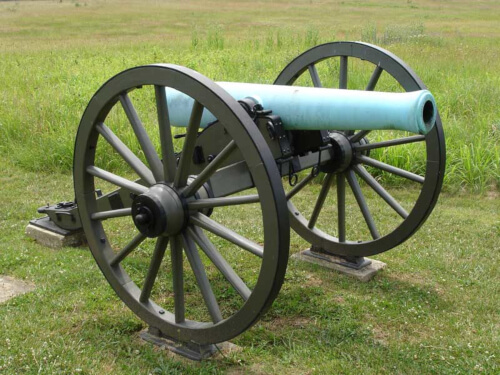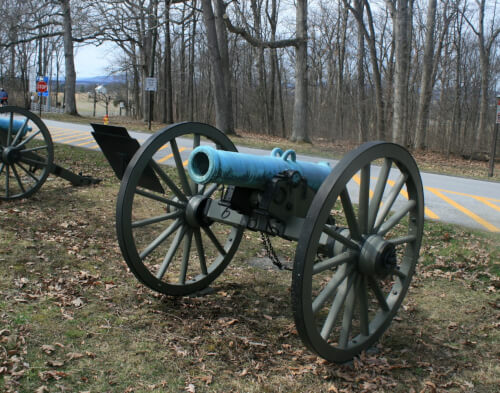Civil War Arms and Equipment
Exploring the weapons and technology of the Civil WarCivil War Artillery
During the Civil War, artillery was an extremely important part in battles. The Union Army classified artillery into 300 types, depending on the gun’s weight and intended use. Field artillery were lighter pieces that often traveled with the armies. Siege and garrison artillery were heavy pieces that could be used either in attacking or defending fortified places. Seacoast artillery were the heaviest pieces and were intended to be used in permanent fortifications. The most well known and famous of the artillery was the 12-pounder Napoleon.
The Parrott Rifle
Parrott Rifle was invented in 1860 by Robert Parker Parrott who was a West Point graduate. Parrott Rifles were manufactured with a combination of cast and wrought iron. The cast iron made for an accurate gun, but was brittle and caused the barrel to suffer fractures. Because of this flaw, a large wrought iron reinforcing band was overlaid on the breech to give it additional strength. Parrott Rifles were made in different sizes from 10-pounders up to the rare 300-pounders. The barrel of the canon weighed over 1,800 pounds and it came in two different diameters including the 2.9 inch which was 74 millimeters and the 3.0 inch which was 76 millimeters. Then by the end of the Civil War, both sides were using this unique piece of Civil War Artillery.
The Napoleon
The Napoleon twelve-pound cannon was the most popular cannon used during the Civil War. It was named after Napoleon III of France and was widely admired because of its safety, reliability, and effectiveness, especially at close range. It was the last cast bronze gun used by an American army. The Federal version of the Napoleon cannon can be recognized by the front end of the barrel called the muzzle swell. Confederate Napoleons were produced in at least six variations. The twelve-pound cannon is a cannon that fires twelve-pound little projectiles from the barrel known as solid shot. It also can shoot grapeshot, chain shot, and a canister shot.
Howitzers
Howitzers were short-barreled guns that were optimized for firing explosive shells in a high trajectory, but also for spherical case shot and canister, over a shorter range than the guns. While field use alluded to firing at targets consisting of enemy forces arrayed in the open, howitzers were considered the weapon of choice if the opposing forces were concealed behind terrain features or fortifications. It cost about $500. Howitzers used lower powder charges than guns of corresponding caliber. Field howitzer calibers used in the Civil War were 12-pounder (4.62-inch bore), 24-pounder (5.82-inch bore), and 32-pounder (6.41-inch bore). Most of the howitzers used in the war were bronze, with notable exceptions of some of the Confederate manufacturers.
Siege Cannon
Siege artillery is heavy artillery primarily used in military attacks on fortified positions.
Ammunition
Grape Shot
Grapeshot is a type of ammunition that contains numerous small metal balls or slugs packed tightly into a canvas bag. After being fired, the bag burned away and the balls spread out from the muzzle similar to a giant shotgun. Grapeshot was very effective against infantry, especially at short range and was used to quickly decimate massed infantry charges.
Canister Shot
Canister shot was similar to grapeshot, was also a type of anti-personnel ammunition. Canister shot was made up of a hollow iron or tin can that held round iron or lead balls, about the size of golf balls, that were packed in sawdust. Attached to the canister was a cloth bag full of gun powder and a sabot. A sabot was a piece of wood or metal attached to the shell to help guide it down the barrel of the canon. Similar to grapeshot, canister acted like a large shotgun.
Shot
Solid shot, or shot, was a type of ammunition that had no explosive charge and were sometimes referred to as cannon balls or bolts depending on their shape. Since it lacked an explosive, solid shot was designed to strike an object and cause damage through the force of the impact. Think of it like getting hit with a baseball coming at you at 100mph. In addition to destroying enemy canons and fortifications, solid shot was also effective for mowing down columns of infantry and cavalry and had psychological effects against its targets.
While rifled cannon had much greater accuracy on average than smoothbores, the smoothbores had an advantage firing round shot relative to the bolts fired from rifled pieces. Round shot could be employed in ricochet or rolling fire extending the depth and range of its effect on land or water while bolts tended to dig in rather than ricochet.
Shell
Shells included an explosive charge and were designed to burst into fragments in the midst of enemy infantry or artillery. For smoothbores, the projectile was referred to as “spherical shell”. Shells were more effective against troops behind obstacles or earthworks, and they were good for destroying wooden buildings by setting them on fire. They were ineffective against good quality masonry.[32] A primary weakness of shell was that it typically produced only a few large fragments, the count increasing with caliber of the shell. A Confederate mid-war innovation perhaps influenced by British ordnance/munition imports was the “polygonal cavity” or “segmented” shell which used a polyhedral cavity core to create lines of weakness in the shell wall that would yield more regular fragmentation patterns—typically 12 similarly sized fragments. While segmented designs were most common in spherical shell, it was applied to specific rifled projectiles as well.[33][34]
Spherical shell used time fuses, while rifled shell could use timed fuse or be detonated on impact by percussion fuse. Fuse reliability was a concern; any shell that buried itself into the earth before detonating had little anti-personnel effectiveness. However, large caliber shells, such as the 32-pounder spherical, were effective at breaching entrenchments.[35]
Learn More
Videos
Vocabulary
Ammunition– bullets,shells, missiles, and other projectiles used as weapons
Artillery– large-caliber guns, e.g. cannons, howitzers, missile launchers, and mortars
Caisson– a two-wheeled horse-drawn vehicle, used to carry ammunition
Limber– a two-wheeled horse-drawn vehicle, used to transport a cannon
Mortar: An unrifled artillery gun which was designed to launch shells over walls and enemy fortifications.
Napoleon: This field artillery piece fired 12 pound projectiles and was very popular with both Federal and Confederate armies.
Ordnance: The term used for military supplies, such as weaponry and ammunition.
Parrott: A rifled artillery piece with a reinforcing band at the rear, or breech.
Shot: A solid, round projectile, shot from a cannon.



